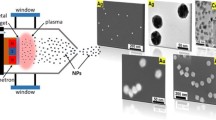Abstract
Syntheses of palladium (Pd) nanoclusters by sputtering gas-condensation technique are reported in this work. The Pd nanocluster size distribution and number of nanoclusters are found to depend on several factors which include the inert gas flow rate (f), sputtering discharge power, and growth region length. The discharge power and the length of the growth region are optimized to produce high nanocluster yield. It is found that low f produces small number of large nanoclusters which can be attributed to the formation of nanoclusters via the two-body collision mechanism. For high f, nanocluster size decreases and the number of nanocluster increases with f. This phenomenon can be assigned to nanocluster formation through three-body collision mechanism.






Similar content being viewed by others
References
Ayesh AI, Lassesson A, Brown SA, Dunbar AD, Kaufmann M, Partridge J, Reichel R, van Lith J (2007) Experimental and simulational study of the operation conditions for a high transmission mass filter. Rev Sci Instrum 78:053906
Ayesh AI, Qamhieh N, Ghamlouche H, Thaker S, EL-Shaer M (2010) Fabrication of size-selected Pd nanoclusters using a magnetron plasma sputtering source. J Appl Phys 107:034317
Banerjee AN, Krishna R, Das B (2008) Size controlled deposition of Cu and Si nano-clusters by an ultra-high vacuum sputtering gas aggregation technique. Appl Phys A 90:299–303
Busani R, Folkers M, Cheshnovsky O (1998) Direct observation of band-gap closure in mercury clusters. Phys Rev Lett 81:3836–3839
Dawson PH (1976) Quadrupole mass spectrometry and its applications. Elsevier Press, Amsterdam
de Heer WA (1993) The physics of simple metal clusters: experimental aspects and simple models. Rev Mod Phys 65:611–676
Haberland H (1992) US Patent no. 5110435
Haberland H (1995) Nanoclusters of atoms and molecules. Springer, Berlin
Haberland H, Karrais M, Mall M, Thurner Y (1992) Thin-films from energetic cluster impact—a feasibility study. J Vac Sci Technol A 10:3266–3271
Hanneken JW, Baker DB, Conradic MS, Eastmand JA (2002) NMR study of the nanocrystalline palladium-hydrogen system. J Alloy Compd 330:714–717
Hicken R (2003) Ultrafast nanomagnets: seeing data storage in a new light. Phil Trans R Soc Lond A 361:2827
Hihara T, Sumiyama K (1998) Formation and size control of a Ni cluster by plasma gas condensation. J App Phys 84:5270–5276
Kappes M, Leutwyler S (1988) Molecular beams of clusters. In: Scoles G (ed) Atomic and molecular beam methods, vol 1. Oxford University Press, New York
Knauer W (1987) Formation of large metal-clusters by surface nucleation. J Appl Phys 62:841–851
Pfeiffer Vacuum GmbH, Pfeiffer Quadrupole mass filter user manual, Germany
Pratontep S, Carroll SJ, Xirouchaki C, Streun M, Palmer R (2005) Size-selected cluster beam source based on radio frequency magnetron plasma sputtering and gas condensation. Rev Sci Instrum 76:045103
Reichel R, Partridge JG, Dunbar ADF, Brown SA, Caughley O, Ayesh A (2006) Construction and application of a UHV compatible cluster deposition system. J Nanopart Res 8:405–416
van Lith J, Lassesson A, Brown SA, Schulze M, Partridge JG, Ayesh A (2007) A hydrogen sensor based on tunneling between palladium clusters. Appl Phys Lett 91:181910
Watari N, Ohnishi S, Ishii Y (2000) Hydrogen storage in Pd clusters. J Phys Condens Matter 12:6799–6823
Yamamuro S, Sumiyama K, Sakurai W, Suzuki K (1998) Cr cluster deposition by plasma-gas-condensation method. Supramol Sci 5:239–245
Yatsuya S, Kamakura T, Yamauchi K, Mihama K (1986) A new technique for the formation of ultrafine particles by sputtering. Jpn J Appl Phys Part 2 25:L42–L44
Author information
Authors and Affiliations
Corresponding author
Rights and permissions
About this article
Cite this article
Ayesh, A.I., Thaker, S., Qamhieh, N. et al. Size-controlled Pd nanocluster grown by plasma gas-condensation method. J Nanopart Res 13, 1125–1131 (2011). https://doi.org/10.1007/s11051-010-0104-2
Received:
Accepted:
Published:
Issue Date:
DOI: https://doi.org/10.1007/s11051-010-0104-2




